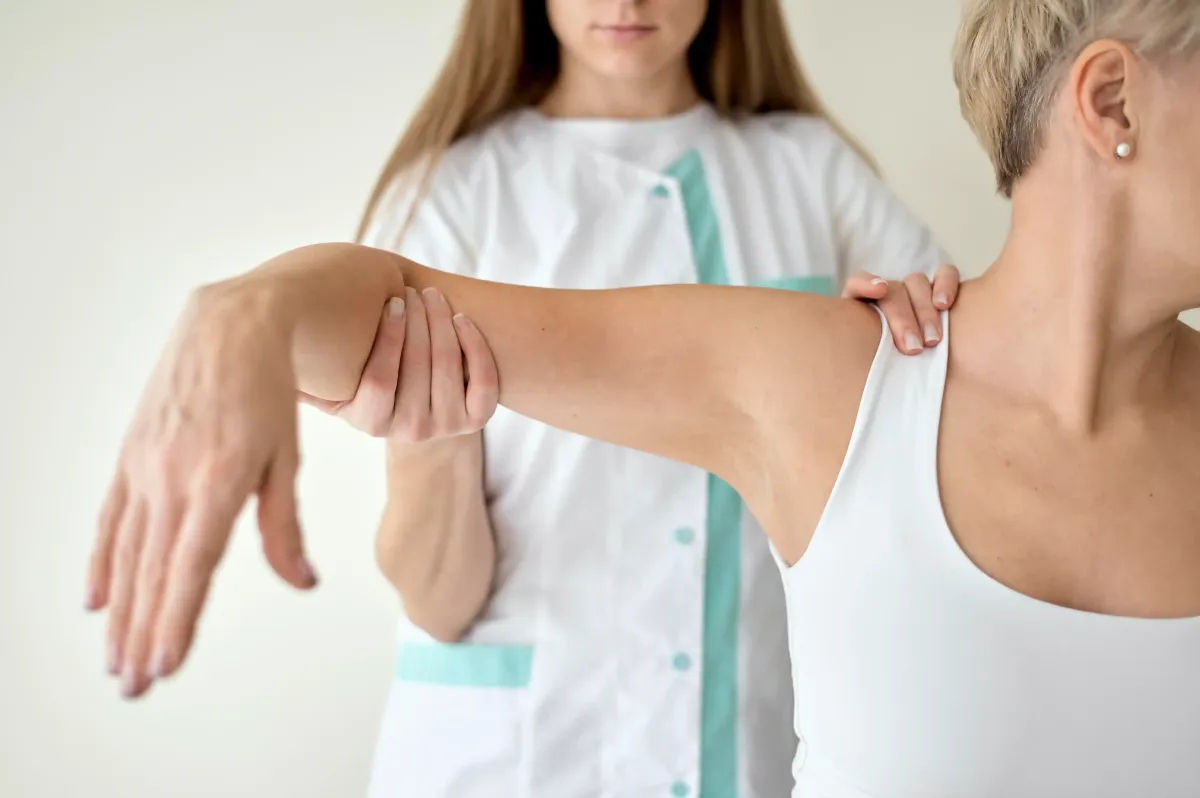Shoulder Labrum & SLAP Tear Treatment in NYC
Manhattan Physical Therapy

What Is a Shoulder Labrum Tear?
The labrum is a ring of soft cartilage that surrounds the socket of your shoulder joint, known as the glenoid. It acts as a cushion and stabilizer, helping the head of your upper arm bone (humerus) fit securely into the socket. When the labrum is torn, it can cause pain, weakness, and a sense of instability in the shoulder.
There are several types of labrum tears, but one of the most common — especially among athletes and active adults — is the SLAP tear, which stands for Superior Labrum Anterior and Posterior. This means the tear occurs at the top of the labrum, where the biceps tendon attaches, extending from the front (anterior) to the back (posterior) of the joint.
SLAP tears can range from mild fraying of the cartilage to complete detachment of the labrum from the bone. Without proper treatment, even small tears can worsen over time, leading to chronic shoulder pain or instability.
What Causes a Labrum or SLAP Tear?
A labrum or SLAP tear can result from trauma, repetitive strain, or gradual wear and tear. In a city like New York, where people are constantly on the move, it’s common to see shoulder injuries caused by a mix of these factors.
Here are the main causes:
Overuse and repetitive motion – Frequent overhead movements, such as throwing, swimming, or lifting weights, can strain the labrum over time.
Sudden injury or trauma – A fall onto an outstretched arm, a direct shoulder impact, or a car accident can tear the labrum abruptly.
Age-related degeneration – As you age, the labrum naturally loses some of its elasticity and resilience, making it more prone to fraying and tearing.
Athletes — particularly baseball players, volleyball players, and tennis players — are especially susceptible to SLAP tears due to repetitive overhead activity. However, office workers and those with active lifestyles can also develop this injury simply through overuse or poor posture.
What Are the Symptoms of a Labrum SLAP Tear?
A shoulder labrum or SLAP tear doesn’t always cause constant pain, which can make it tricky to diagnose without a professional evaluation. The discomfort often comes and goes, especially during certain movements.
Common signs include:
Deep, dull shoulder pain or sharp pain during overhead activity
A feeling that the shoulder “catches” or “locks” when moving
A sensation that the shoulder might pop out of place
Decreased range of motion or stiffness
Weakness when lifting or throwing
Clicking or grinding sounds when rotating the shoulder
Source: WebMD
How Is a Labrum SLAP Tear Diagnosed?
Diagnosing a SLAP tear requires a thorough evaluation by a shoulder specialist or physical therapist. At Manhattan Physical Therapy, we start with a detailed assessment to understand your symptoms, lifestyle, and activity level.
Your provider may:
Perform physical tests that involve gentle movement of your arm to assess stability, range of motion, and pain triggers.
Recommend imaging tests like MRI or MRI arthrogram (an MRI with contrast dye) to visualize the soft tissue structures in your shoulder.
Evaluate for related injuries, such as rotator cuff tears or biceps tendon damage, which commonly accompany labral tears.
Accurate diagnosis is crucial — not just to confirm a SLAP tear, but to determine whether conservative, non-surgical treatment is appropriate. In most cases, physical therapy is the first line of treatment and can significantly improve function without the need for surgery.
How Is a SLAP Tear Treated Without Surgery?
Not every labrum or SLAP tear requires surgery. In fact, many people in NYC recover fully through a structured, non-surgical treatment plan. The key is identifying the severity of the tear and addressing the underlying causes — such as muscle weakness, poor posture, or repetitive stress.
Conservative treatments for SLAP tears often include:
Rest and activity modification
Anti-inflammatory medications
Corticosteroid injections
Physical therapy
How Physical Therapy Helps Heal a SLAP Tear
Your rehabilitation program is tailored to your specific needs and may include a mix of hands-on treatment, guided exercises, and education.
We begin with manual therapy, using gentle techniques that ease stiffness, improve mobility, and reduce pain around the shoulder joint. Restoring normal joint motion is often the first step toward long-term recovery.
Next, we introduce targeted strengthening exercises that focus on the rotator cuff and muscles around your shoulder blade. These muscles are crucial for keeping your shoulder stable and preventing further strain on the labrum.
We also work on postural correction to reduce stress on your shoulder during daily activities. Improving posture helps maintain better alignment and minimizes the risk of future injuries.
As you progress, we incorporate functional retraining to simulate the movements you perform at work, in sports, or during daily life. This helps your shoulder adapt safely and regain full performance.
Finally, we provide education and a home exercise plan so you can continue strengthening your shoulder outside the clinic. Learning proper movement mechanics and self-care techniques ensures that your recovery lasts.
Real Patient Experiences
"Absolutely do your physical therapy and take things slow. The first 6 weeks were miserable, but after that the pain was a lot more manageable. I did physical therapy for a little over 3 months after the surgery. Once a week but did the exercises at home as much as my PT had prescribed."
"I had a SLAP tear repaired on my non-dominant shoulder four years ago. I was allowed to sleep out of the sling after a week, and the sling came off after 2-3 weeks. By week 6 I was well into PT."
"It was probably closer to nine months than three months for mine before it felt totally normal, but after three or four months I shoot my bow. ++physical therapy."
When Should You See a Specialist for Shoulder Pain?
You shouldn’t ignore persistent shoulder pain, especially if it doesn’t improve with rest or interferes with your daily routine. If you experience any of the following, it’s time to consult a professional:
Pain that worsens with overhead movement
A sensation that your shoulder “pops” or “grinds”
Weakness or loss of strength in your arm
Difficulty reaching behind your back
Limited shoulder motion or stiffness that persists
Delaying treatment can make recovery more challenging and increase the likelihood of needing surgery. A licensed physical therapist can evaluate your shoulder, determine whether you have a SLAP or labrum tear, and guide you toward the most effective treatment plan.
If shoulder pain is holding you back, it’s time to take action. Call (212)-213-3480 today to schedule an appointment at Manhattan Physical Therapy.
What Do They Say About Us?
Alexander Liu
"Everyone on the team at Manhattan Physical Therapy is super nice and caring. They were able to pretty quickly diagnose my knee and hip problems and immediately put me to work to reduce the pain.."
Henry Myerberg
"You're not just a patient when you come to the Manhattan Physical Therapy. You feel like family there. In particular, Erica with her colleagues John, Lidia and Joe not only fix and improve you physically, they make you feel welcomed and cared for.."
Hakyung Kim
"Everyone is so kind and helpful! my knee and hip pain have improved massively since starting Manhattan PT, highly recommend to anyone. special thanks to Bianca, Lidia, Joe, and John!"
Manhattan Physical Therapy
✆ Phone (appointments):
(212) 213-3480
Address: 385 5th Ave, Suite 503, New York, NY 10016

